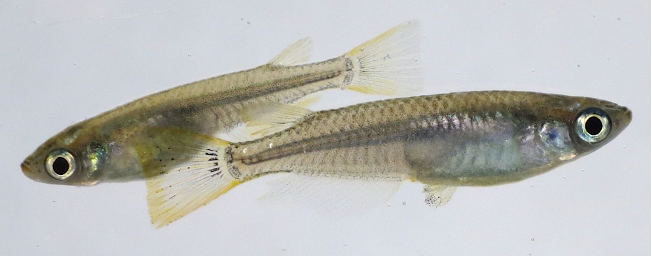Medaka Facility
The medaka fish facility is an infrastructure of the Institute of Biological and Chemical systems/Biological Information Processing (IBCS-BIP), located at the Campus-North of KIT. It houses 4000 fish tanks of different capacities arranged in 7 rooms, each allowing individual control of room temperature and lighting conditions. Thus, husbandry conditions can be adjusted to the needs of different teleost species and this also enables testing the effects of environmental parameters. This is particularly important when working with species that are native to temperate habitats with seasonal changes, such as medaka (Koger et al., 1999; Lopez-Olmeida et al., 2021).
“Breeding rooms” are maintained at 26 degrees with a 14/10 light/dark cycle to simulate summer conditions. Instead, “Winter rooms” are set to 22 degrees with a 10/14 light/dark cycle. Under these conditions medaka do not mate and their life span is doubled to about 2 years. The maximal capacity of the medaka facility is close to 30.000 adult fish. Most of the facility is used to maintain the medaka MIKK inbred panel, as inbred lines cannot be stored as cryopreserved sperm. Currently the medaka fish facility also houses several Oryzias species and zebrafish (Danio rerio).

In addition to the medaka fish facility, IBCS-BIP has established and maintains the European Zebrafish Resource center EZRC as well as the Zebrafish facility. Together these infrastructures represent Europe's largest center for maintaining fish model systems for biological research.
The medaka fish facility also makes a key contribution to the International Zebrafish and Medaka course. This FELASA-certified course offered by IBCS-BIP teaches all relevant aspects of zebrafish and medaka husbandry. This popular, on-site course comprises theoretical and practical elements, including practical teaching at the medaka and zebrafish facilities.
Medaka
The main focus of the medaka facility is the breeding and maintenance of inbred strains of the genus Oryzias. This genus comprises about 20 species that are native to South-East Asia, covering a wide range of different habitats from tropical to temperate. In biological sciences, the Japanese medaka, Oryzias latipes, is a commonly used animal model species.
The Japanese medaka is a well-established vertebrate model with a long history of genetic studies (Takeda and Shimada, 2010, Kirchmaier et al., 2015). In Japan, this small freshwater teleost is a very popular ornamental fish and over the centuries several spontaneous pigmentation mutants have been identified and bred true. These mutants were the basis for genetic studies that started over a hundred years ago (Toyama, 1916). As a vertebrate animal model for biological research, medaka combines several key features, including economical and easy husbandry, high fecundity as well as transparency of embryos and largely also adults. Medaka is widely used for molecular-genetic analysis of development, sex determination, social behaviour and population genetics.

Importantly, medaka is highly tolerant to inbreeding from the wild. Hyodo-Taguchi started to establish inbred strains over fifty years ago (Hyodo-Taguchi, 1980). Several of these strains have been maintained by inbreeding for over 100 generations and are available through the Medaka Resource center in Okazaki, Japan. This key feature in combination with the ease to isolate wild catches rendered medaka an ideal vertebrate model to embark on the establishment of a panel of near-isogenic lines from a wild catch. The Loosli group has used 9 generations of single full sibling pair-crosses to establish 80 inbred strains from the Kiyosu wild population (Fitzgerald et al., 2022). The resulting Medaka Inbred Kiyosu Karlsruhe (MIKK) panel with a good representation of wild alleles of the original Kiyosu wild population, is a unique resource for genetic association and mapping studies.

References
Fitzgerald, T., Brettell, I., Leger, A., Wolf, N., Kusminski, N., Monahan, J., Barton, C., Herder, C., Aadepu, N., Gierten, J., Becker, C., Hammouda, O., Hasel, E., Lischik, C., Lust, K., Sokolova, N., Suzuki, R., Tsingos, E., Tavhelidse, T., Thumberger, T., Watson, P., Welz, B., Khouja, N., Naruse, K., Birney, E., Wittbrodt, J., & Loosli, F. (2022). The Medaka Inbred Kiyosu-Karlsruhe (MIKK) panel. Genome Biology, 23(1), 59.
Hyodo-Taguchi,Y, 1980. Establishment of inbred strains of the teleost, Oryzias latipes. ci.nii.ac.jp [Internet]. 1980; Availablefrom: http://ci.nii.ac.jp/naid/10005820467/
Koger, C., Teh, S., & Hinton, D. (1999). Variations of light and temperature regimes and resulting effects on reproductive parameters in medaka (Oryzias latipes).. Biology of reproduction, 61(5), 1287 – 1293.
López-Olmeda, J., Zhao, H., Reischl, M., Pylatiuk, C., Lucon-Xiccato, T., Loosli, F., & Foulkes, N. (2021). Long photoperiod impairs learning in male but not female medaka. iScience, 24(7), 102784.
S Kirchmaier, K Naruse, J Wittbrodt, F Loosli, 2015. The genomic and genetic toolbox of the teleost medaka (Oryzias latipes). Genetics.
H Takeda, A Shimada 2010. The art of medaka genetics and genomics: what makes them so unique? Annu Rev Genet.
K Toyama, 1916. On some Mendelian characters (in Japanese). Rep Jap Breed Soc.
